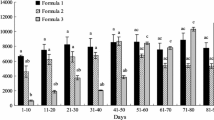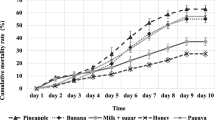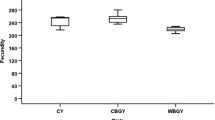Abstract
The pupal parasitoidBrachymeria intermedia (Nees) was reared from the egg to adult stage on artificial media based on commercial meat homogenates for babies (Plasmon®), either with or devoid of host components. Six media containing 80% homogenate and 20% extract ofGalleria mellonella L. pupae were tested first. Two types of homogenates, intended for babies at the beginning of weaning (a) and well on in weaning (b), were utilized. Media were based on beef, veal and chicken meat, 3 on a-homogenates and 3 on b-homogenates. A significantly higher percentage of parasitoids developed as mature larvae on the a- than on the b-homogenate based diets. This was presumably related to the higher protein, carbohydrate, lipid and calorie level of the a- than of the b- homogenates. Diet veal-a produced the best mean adult yield (27.4%). Other two diets based on the veal-a homogenate were then tested. The first, composed of 80% homogenate, 10% host pupal extract, 7% chicken egg yolk, 1.5% yeast extract and 1.5% wheat germ, produced a mean adult yield of 66.7%, similar to that obtained inG. mellonella pupae. On the second medium, devoid of host components and containing 85% veal-a homogenate, 10% chicken egg yolk, 2.5% wheat germ and 2.5% yeast extract, the mean adult yield was 22.5%. In all media, the adults obtained were viable and fecund.
Résumé
Le parasitoïde nymphalBrachymeria intermedia (Nees) a été élevé, de l’œuf au stade adulte, sur des milieux artificiels à base de viandes homogénéisées pour bébés, vendues dans le commerce (Plasmon®), à la fois avec ou sans matériel dérivant de l’hôte. Six milieux contenant 80% d’homogénat et 20 % d’extrait de chrysalides deGalleria mellonella L. ont d’abord été testés. Deux types d’homogénats destinés respectivement à des bébés en début de sevrage (a) et en phase de sevrage avancé (b) ont été utilisés. Pour chaque type d’homogénat, trois sortes de viande ont été testées: boeuf, veau et poulet. Les milieux à base d’homogénats de type « a » ont été plus efficaces que ceux à base d’homogénats de type « b » en ce qui concerne les pourcentages de larves en fin de développement obtenus. Cela est probablement dû au fait que les homogénats de type « a » ont une teneur plus élevée en protéines, carbohydrates, lipides et calories. Le pourcentage d’adultes le plus élevé (27,4%) a été obtenu avec le milieu à base d’homogénat de veau de type « a ». Deux milieux à base d’homogénat de veau de type « a » ont ensuite été testés. Sur le premier, contenant 80% d’homogénat, 10% d’extrait de chrysalides deG. mellonella, 75% de jaune d’oeuf, 1,5% de levure et 1,5% de germes de blé, le rendement moyen en adultes a été de 66,7%, semblable au rendement obtenu sur des chrysalides deG. mellonella. Le deuxième milieu, dépourvu de matériel dérivant de l’hôte, contenait 85% d’homogénat, 10% de jaune d’oeuf, 2,5% de germes de blé et 2,5% de levure. Le rendement obtenu sur ce milieu a été de 22,5%. Sur tous les milieux les adultes obtenus étaient viables et féconds.
Similar content being viewed by others
References
Bratti, A. — 1989. Allevamentoin vitro diPseudogonia rufifrons Wied. in estratti di omogeneizzato di crisalidi diGalleria mellonella L. e su diete meridiche. —Boll. Ist. Ent. ‘G. Grandi’ Univ. Bologna, 44, 11–22.
Bratti, A. — 1990. Tecniche di allevamentoin vitro per gli stadi larvali di insetti entomofagi parassiti. —Boll. Ist. Ent. "G. Grandi" Univ. Bologna, 44, 169–220.
Bratti, A. &Monti, M. — 1988. Allevamentoin vitro delle larve diPseudogonia rufifrons Wied. (Dipt. Tachinidae) su omogeneizzato di crisalidi diGalleria mellonella L. (Lep. Galleriidae). —Boll. Ist. Ent. "G. Grandi" Univ. Bologna, 43, 115–126.
Bratti, A., Campadelli, G. &Mariani, M. — 1995.In vitro rearing ofExorista larvarum (L.) on diet without insect components. —Boll. Ist. Ent. "G. Grandi" Univ. Bologna, 49, 225–236.
Campadelli, G. — 1973. Allevamento diGalleria mellonella L. con dieta semi-artificiale. —Boll. Ist. Ent. Univ. Bologna, 32, 11–25.
Dindo, M. L. — 1990. Alcune osservazioni sulla biologia diBrachymeria intermedia (Nees) (Hym. Chalcididae)in vivo e in vitro. —Boll. Ist. Ent. "G. Grandi" Univ. Bologna, 44, 221–232.
Dindo, M. L., Sama, C. & Farneti, R. — 1994.In vitro rearing ofBrachymeria intermedia (Nees) (Hymenoptera Chalcididae) on veal-homogenate based diets. —Norw. J. Agric. Sci., Suppl. 16, 395.
Dindo, M. L., Gardenghi, G. &Grasso, M. — 1995. Notes on the anatomy and histology of the female reproductive system ofBrachymeria intermedia (Nees) (Hymenoptera Chalcididae) rearedin vivo andin vitro. —Boll. Ist. Ent. "G. Grandi" Univ. Bologna, 50, 5–13.
Dowden, P. B. — 1935.Brachymeria intermedia (Nees), a primary parasite, andB. compsilurae, a secondary parasite, of the gypsy moth. —J. Agr. Res., 50, 495–523.
Grenier, S., Delobel, B. &Bonnot, G. — 1986. Physiological considerations of importance to the success ofin vitro culture: an overview. —J. Insect Physiol., 32, 403–408.
Grenier, S., Greany, P. D. &Cohen, A. C. — 1994. Potential for mass release of insect parasitoids and predators through development of artificial culture techniques. In: Pest Management in the Subtropics Biological Control — a Florida Perspective —Intercept Ltd, Andover, 181–205.
House, H. L. — 1977. Nutrition of natural enemies. In: Biological control by augmentation of natural enemies (R. L. Ridgeway &S. B. Vinson, eds.) —Plenum Press, New York, 150–182.
Mellini, E. &Campadelli, G. — 1994. Qualitative improvements in the composition of oligidic diets for the parasitoidExorista larvarum (L.). —Boll. Ist. Ent. "G. Grandi" Univ. Bologna, 49, 187–196.
Mellini, E. &Campadelli, G. — 1995. Further simplifications in the composition of oligidic diets for the parasitoidExorista larvarum (L.). —Boll. Ist. Ent. "G. Grandi" Univ. Bologna, 49, 211–223.
Minot, M. C. &Leonard, D. E. — 1976a. Host preference and development of the parasitoidBrachymeria intermedia inLymantria dispar, Galleria mellonella andChoristoneura fumiferana. —Environ. Entomol., 5, 527–532.
Minot, M. C. &Leonard, D. E. — 1976b. Effect of temperature, humidity, light and gravity on the parasitoidBrachymeria intermedia. —Environ. Entomol., 5, 427–430.
Mosteller, F. M. &Youtz, C. — 1961. Tables of the Freeman-Tukey transformations for the binomial and Poisson distributions. —Biometrika, 48, 433–440.
Snedecor, G. W. &Cochran, W. G. — 1980. Statistical methods. —Iowa State University Press, Ames, 507 p.
Stowell, S. D. &Coppel, H. C. — 1990. Mass rearing the gypsy moth parasitoidsBrachymeria lasus andBrachymeria intermedia (Hymenoptera: Chalcididae) for small-scale laboratory studies. —Great Lakes Entomol., 23, 5–8.
Thompson, S. N. — 1980. Artificial culture techniques for rearing larvae of the chalcidoid parasite,Brachymeria intermedia. —Entomol. exp. appl., 27, 133–143.
Thompson, S. N. — 1981a.Brachymeria lasus: culturein vitro of a chalcid insect parasite. —Exp. Parasitol., 52, 414–418.
Thompson, S. N. — 1981b.Brachymeria lasus andPachycrepoideus vindimiae: sterol requirements during larval growth of two hymenopterous insect parasites rearedin vitro on chemically defined media. —Exp. Parasitol., 51, 220–235.
Thompson, S. N. — 1981c. Essential amino acid requirements of four species of parasitic Hymenoptera. —Comp. Biochem. Physiol., 69, 173–174.
Thompson, S. N. — 1983a.Brachymeria lasus: effects of nutrient level onin vitro larval growth of a chalcid insect parasite. —Exp. Parasitol., 55, 312–319.
Thompson, S. N. — 1983b. Larval growth of the insect parasiteBrachymeria lasus rearedin vitro. —J. Parasitol., 69, 425–427.
Thompson, S. N. — 1986. Nutrition andin vitro culture of insect parasitoids. —Annu. Rev. Entomol., 31, 197–219.
Zar, J. H. — 1984. Biostatistical Analysis. —Prentice Hall. Englewood Cliffs, 718 p.
Author information
Authors and Affiliations
Rights and permissions
About this article
Cite this article
Dindo, M.L., Sama, C., Fanti, P. et al. In vitro rearing of the pupal parasitoidBrachymeria intermedia (Hym.: Chalcididae) on artificial diets with and without host components. BioControl 42, 445–453 (1997). https://doi.org/10.1007/BF02769838
Received:
Accepted:
Published:
Issue Date:
DOI: https://doi.org/10.1007/BF02769838




